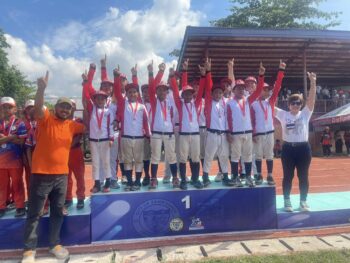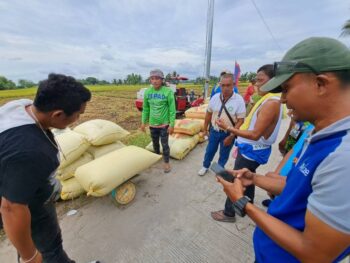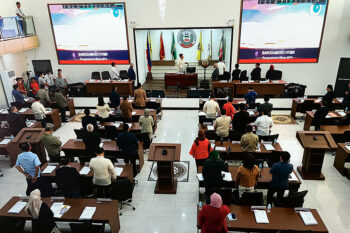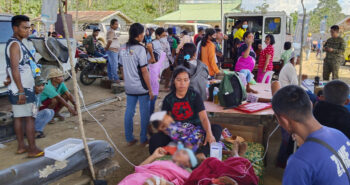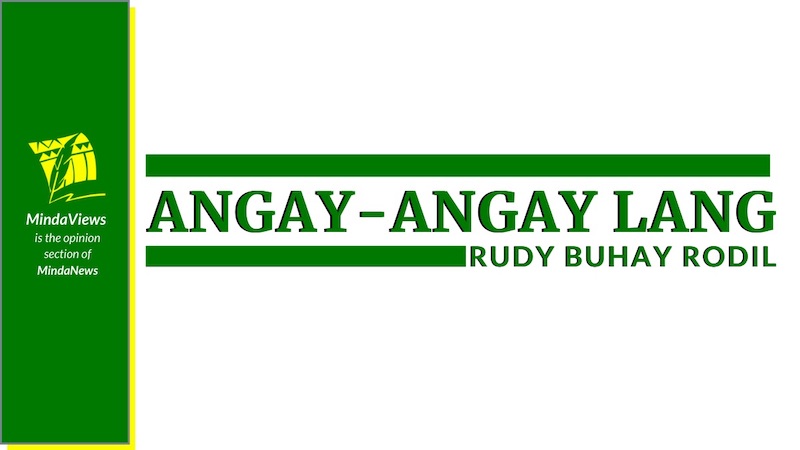
9th of 18 parts
(This is a revised version of the book “KALINAW MINDANAW: The Story of the GRP-MNLF Peace Process, 1975-1996” published in 2000)
Presidential Intervention Unfolds; Marcos Taps First Lady Again
Two strategic moves were made by the President. First, he sent the First Lady to Libya to break the deadlock and prevent an indefinite postponement or the possible cancellation of the already scheduled plebiscite. Second, he reversed his position from pro-merger to anti-merger. As if by a given signal, Simeon Datumanong, Commissioner of Region 12; Mohammad Ali Dimaporo, governor of Lanao del Sur and Officer-in-Charge of the Mindanao State University; Governor Carlos Cajelo of North Cotabato; Governor Arsenio Quibranza of Lanao del Norte; Governor Muss Izquierdo of Sulu, and Governor Cerilles of Zamboanga del Sur – unanimously reported an increasing anti-merger trend!
On the side, there were petitions from the Pagadian Chapter of the Integrated Bar of the Philippines and the Maguindanao Professionals Association to the COMELEC for the postponement of the plebiscite, which COMELEC Chairman Leonardo Perez promptly dismissed, and the very next day, decided to reconsider.
On 16 March, President Marcos made another postponement, this time to April 21 – reportedly on the recommendations of government and civic groups, including the COMELEC, the Department of National Defense, the DLGCD, and Integrated Bar of the Philippines and the First Lady’s mission to Libya. The reason was the same as the previous one, “for clarification of the issues involved” and a new addition, “to enable the negotiations in Tripoli to continue.”
The information campaign was reportedly intensified, this time in the dialect because previous efforts have been in English, and yet until this time the Tripoli agreement still had to see print! Tham Manjoorsa, MNLF chief representative to the ceasefire committee, said the MNLF will boycott the plebiscite.
On March 17, the President rescheduled the plebiscite to April 17.
There were more reports of MNLF ceasefire violations. Marcos’ solution was reportedly approved at Tripoli (no details given). MRLM backed the plebiscite, but opposed the MNLF boycott. Residents of Davao del Sur, South Cotabato and Palawan opposed the merger, said their respective governors.
Exchange of Cables between Marcos and Khaddafy
Following the First Lady’s trip to Libya was the exchange of cables between President Marcos and President Khaddafy of 17-18 March, also known as the Marcos-Khaddafy three-point agreement, as follows:
- A decision declaring autonomy in the 13 areas defined by the Tripoli agreement.
- A provisional government for the autonomy to be formed by a decision issued by the President of the Republic in which the concerned parties from the Moro National Liberation Front and the inhabitants of the areas of the autonomy may take part.
- This provisional government will hold a referendum in the areas of autonomy concerning the administrative arrangements within the areas of autonomy in accordance with Article XI (3) of the Philippine Constitution (1973) and this means that people be asked to organize themselves administratively within the areas of autonomy.
President Marcos immediately issued a proclamation declaring autonomy in the 13 provinces, and created the provisional government, part of whose task was to prepare the referendum in the area of autonomy, prepare for the election of the regional assembly in said area and administer the region in accordance with existing laws.
New Referendum Questions Published
The referendum-plebiscite questions were finalized on April 1, but these were not published until April 2 and April 17. The two questions cited earlier were still there. The nine questions in the remark sheets directly attacked what was published earlier as the MNLF stand, such as the MNLF intent to control the autonomous region, their plan for the region to have its own flag, official language and seal, their desire to be called Bangsamoro rather than Filipino, their idea of organizing an independent and separate security force, independence from the Republic’s auditing regulations, and so on.
People from the 13 provinces (no identities given) allegedly sought the expansion of the questions to include clarifications on the specific role of the MNLF in the autonomous region. More specific questions sought the ratification by their respective citizens of various presidential decrees, promulgated and implemented a few years back, creating the provinces of Sultan Kudarat, Maguindanao, North Cotabato, Basilan and Tawi-Tawi.
Nur Misuari and fourteen top MNLF members were invited to serve as members of the provisional government. Misuari was offered the chairmanship and Abulkayr Alonto the vice chairmanship. The letters of the invitation were separately addressed to each one of the fifteen.
President Marcos took a trip to Mindanaw. In a speech at the Kawasaki Sintering Plant at PHIVIDEC, Nabacaan, Misamis Oriental, he challenged the MNLF leadership to “come back to the Philippines and join him in facing the people in search for a peaceful solution to the Mindanaw conflict.” He also reiterated that regardless of the outcome of the referendum-plebiscite, he would call an election to determine whom the people really want to rule the areas of the autonomy. Given these government initiatives, the national government could not now be faulted for any resumption in the fighting.
At a two-hour pulong-pulong (consultation-meeting) at the Southcom headquarters in Zamboanga City, he announced Misuari’s acceptance to head the provisional government but gave no other details. One newspaper added that the MNLF leader was due to arrive during the coming week. But the same issue of the same paper noted that MNLF members were campaigning against the MNLF position at the same time inquiring why the MNLF should be the sole spokesman for a region with mixed Muslim and non-Muslim population. Some 400 leaders, all anti-merger, which included barangay leaders, governors and other government officials and leaders of the MRLM, sought the maintenance of the status quo. Maranao mayors from the two Lanaos not only rejected the MNLF position but also vowed to deliver 95% to 98% votes against the MNLF proposal.
Meanwhile, there were also various intriguing reports: of splits in the MNLF ranks due to mishandling by the leadership; of plots to assassinate Misuari as soon as he shows up; that Misuari is rejected in his own hometown because, though a Samal, he passes himself off as Tausug; of alleged Maranao and Maguindanao hostility towards the MNLF leaders due to his discrimination in the composition of the central committee, that is, that most of the members are Tausug.
There was truth on the reported split in the MNLF leadership. As early as March, stories about the Salamat Hashim breakaway from the MNLF Central Committee filtered and spread in Moroland. “The breaking point came on September 21, 1977, right after the collapse of the GRP-MNLF talks in Manila, when 57 leading officers of the Kutawato Revolutionary Committee (KRC) signed a petition addressed to the Organization of Islamic conference (OIC) and the Muslim World League (MWL) calling for the ouster of Nur Misuari as Chairman of the MNLF and, in his stead, recognizing Salamat Hashim as the new Chair.” This did not materialize. But that started a series of major splits in the MNLF leading to the existence also of the MNLF-Reformist Group. In March 1984, the Salamat Hashim group formalized their separate existence as the Moro Islamic Liberation Front (MILF).
Romulo Espaldon, Southcom Commander, vowed to exert all efforts to provide maximum security to Misuari should he come to observe the referendum-plebiscite.
On the same day that Tham Manjoorsa announced the MNLF’s non-participation in the referendum-plebiscite, the press reported that Misuari was coming.
Protests against the Plebiscite
Three days before the voting, President Khaddafy objected to the referendum-plebiscite questions and procedures; the next day, Ahmadu Karim Gaye, Secretary General of the Islamic Conference issued his own objections; on the same day, Tham Manjoorsa announced the MNLF’s refusal to take part in the farce. On the same day (16 April), almost at the same time that Misuari announced his own objections, the press published that he was coming. These notes of protest were never given space in the local media.
As early as 19 April, the COMELEC reported, on the basis of partial returns, that the trend was 1 to 9 against the MNLF proposals and the merger issue. This trend was to remain constant even after the returns have all come in with a slight deviation noted in the case of Sulu and Tawi-Tawi because, according to the media, these are MNLF bailiwicks and the MNLF have done their own campaigning. Misuari was reported to have been totally rejected in his own hometown.
About the only victory the MNLF could boast of was in Simunul. And the press emphasized that this was not due to Misuari’s leadership but rather to two factors, namely, Tham Manjoorsa’s mother comes from this place, and Makdum, the Arab missionary who brought Islam to the Philippines, landed on this site in 1380.
President Marcos expressed his commendation for the MNLF leadership for keeping their word not to disrupt the referendum-plebiscite.
Another Deadlock in Manila
The day before President Marcos was scheduled to address a special session of the Batasang Bayan as well as representatives of Provincial governors and city mayors league, the municipal mayors league, the Pambansang Katipunan ng mga Barangay, the Pambansang Katipunan ng mga Kabataang Barangay at the Philippine International Convention Center (PICC), Foreign Affairs Secretary Carlos P. Romulo reported another deadlock in the third round of talks with the MNLF, held in Manila on April 21-30, 1977, due, he said, to unacceptable demands of the MNLF. The MNLF were reported to have demanded the following:
- Full control of the provisional government through the appointment of 11 members, seven from the MNLF and four (two Muslims and two Christians) to be chosen by the MNLF. The final government for the 13 provinces will be composed of one legislative assembly of 26 members (elective) and five appointive, three of the latter to be recommended by the MNLF. Of the 26 members, the two Muslims each will come from Sulu, Tawi-Tawi, Basilan, Lanao del Sur, and one Muslim and one non-Muslim each from North Cotabato, Zamboanga del Norte, Davao del Sur, South Cotabato and Palawan.
- One executive council for the 13 provinces to be composed of 11 members, seven from the MNLF and four (two Muslims and two non-Muslims) to be chosen by the MNLF.
- A separate military unit for the MNLF representing 25% of the Armed Forces of the Philippines, estimated at 15,000 men, paid for and equipped by the Philippine government, but under the command of the MNLF, and under no circumstances to be employed by the AFP within or outside the area of autonomy.
- The provisional government will have a transition period of six years, with full powers to change governors and mayors and other officers of the government as well as employees.
- The finances of the 13 provinces should be exempt from the standard auditing procedures and audited only by an appointee of the MNLF.
In Secretary Romulo’s words, these demands are violative of the Constitution, of the will of the people expressed during the referendum-plebiscite in the 13 provinces, and of the Tripoli agreement and of the Khaddafy-Marcos accord.
Except for a little quotation from Abdul Rahman Amin, head of the MNLF delegation to the talks in Manila, expressing the MNLF rejection of the referendum-plebiscite results because “it is not in the spirit of the Tripoli Agreement and is not in conformity with the Marcos-Khaddafy agreement,” nothing else was printed which gave the MNLF’s version of the talks.
President Marcos’ address to the nation, done at the PICC on 3 May 1977 was a mere repetition and elaboration of Secretary Romulo’s report. Deploring the MNLF stand as Romulo already did, he said that “the principal blame must fall upon the shoulders of the representatives of the MNLF who had refused to listen to reason.” Of the government’s position, President Marcos declared: “We have been very considerate, solicitous of the welfare of our country and people. We have bent backwards knowing full well that perhaps these demands were made because of the lack of acquaintance with the nature of our government as well as the provisions of our Constitution.” He also added: “we have long renounced war as an instrument of national policy; we shall continue to renounce it.”
(MindaViews is the opinion section of MindaNews. A peace specialist, Rudy Buhay Rodil is an active Mindanao historian and peace advocate.)
Tomorrow: MNLF Reaction


